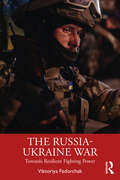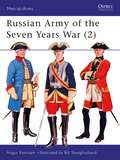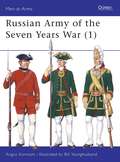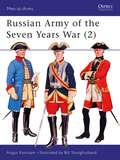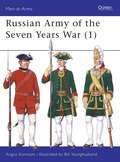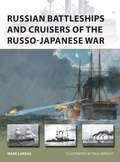- Table View
- List View
Russia Between East and West: Russian Foreign Policy on the Threshhold of the Twenty-First Century (Cummings Center Series)
by Gabriel GorodetskyGabriel Gorodetsky unravels President Putin's efforts to re-establish Russia's position as a major power, attempting to reconcile Russia's traditional national interests with the newly emerging social and political entity taking shape at home.
The Russia-Ukraine War: Towards Resilient Fighting Power (Routledge Advances in Defence Studies)
by Viktoriya FedorchakThis book provides a systematic analysis of the Russian-Ukraine war, using the concept of resilient fighting power to assess the operational performance of both sides during the first year of the full-scale invasion.The Russian war in Ukraine began in 2014 and continued for eight years, before the full-scale invasion of 24 February 2022. It is not a new war, but the intensity of the warfighting revived many discussions about the conduct of inter-state warfare, which has not been seen in Europe for decades. This book does not aim to offer an exhaustive operational analysis of the war, but rather provides a preliminary systematic analysis across various domains of warfare using the concept of fighting power to assess the operational performance of both sides. First, the book discusses the conceptual component and the post-Cold War adaptations of the Soviet strategic tradition by both the Ukrainian and the Russian Armed Forces. Following that, it gives an evaluation of the various aspects of warfighting in the land, air, maritime and cyber domains. Then, the book examines the role of international allied assistance, sanctions and weapons delivery in strengthening the resilience of the Ukrainian Armed Forces. The book concludes with some comments on the role of inter-state warfare in the current strategic environment and future warfare.This book will be of much interest to students of military and strategic studies, defence studies, foreign policy, Russian studies and international relations.
The Russia-Ukraine War: Towards Resilient Fighting Power (Routledge Advances in Defence Studies)
by Viktoriya FedorchakThis book provides a systematic analysis of the Russian-Ukraine war, using the concept of resilient fighting power to assess the operational performance of both sides during the first year of the full-scale invasion.The Russian war in Ukraine began in 2014 and continued for eight years, before the full-scale invasion of 24 February 2022. It is not a new war, but the intensity of the warfighting revived many discussions about the conduct of inter-state warfare, which has not been seen in Europe for decades. This book does not aim to offer an exhaustive operational analysis of the war, but rather provides a preliminary systematic analysis across various domains of warfare using the concept of fighting power to assess the operational performance of both sides. First, the book discusses the conceptual component and the post-Cold War adaptations of the Soviet strategic tradition by both the Ukrainian and the Russian Armed Forces. Following that, it gives an evaluation of the various aspects of warfighting in the land, air, maritime and cyber domains. Then, the book examines the role of international allied assistance, sanctions and weapons delivery in strengthening the resilience of the Ukrainian Armed Forces. The book concludes with some comments on the role of inter-state warfare in the current strategic environment and future warfare.This book will be of much interest to students of military and strategic studies, defence studies, foreign policy, Russian studies and international relations.
Russian Aces of World War 1 (Aircraft of the Aces #111)
by Harry Dempsey Victor KulikovAlthough the Russian Imperial Army Air Service consisted of no more than four BAGs (Boevaya Aviatsionniy Gruppa – battle aviation groups), each controlling three or four smaller AOIs (Aviatsionniy Otryad Istrebitelei – fighter aviation detachments) equipped with a variety of aircraft types, its fighter pilots nevertheless gave a good account of themselves. Indeed, during three years of war they claimed more than 200 Austro-Hungarian and German aircraft shot down, creating 13 aces – these elite aviators accounted for around half of the victories claimed on the Eastern Front. Pilots flew a variety of fighter types, with French Nieuport scouts and SPAD VIIs proving to be the most popular, and effective, aeroplanes to see service on this front. The exploits of these aces are detailed here, with information based on material newly sourced by the author from Russian military and private archives. Many previously unpublished photographs are used to illustrate this book, supported by full-colour profiles that reveal how striking some of the aces' fighters were in this often-forgotten theatre of World War 1.
Russian Aces of World War 1 (Aircraft of the Aces #111)
by Harry Dempsey Victor KulikovAlthough the Russian Imperial Army Air Service consisted of no more than four BAGs (Boevaya Aviatsionniy Gruppa – battle aviation groups), each controlling three or four smaller AOIs (Aviatsionniy Otryad Istrebitelei – fighter aviation detachments) equipped with a variety of aircraft types, its fighter pilots nevertheless gave a good account of themselves. Indeed, during three years of war they claimed more than 200 Austro-Hungarian and German aircraft shot down, creating 13 aces – these elite aviators accounted for around half of the victories claimed on the Eastern Front. Pilots flew a variety of fighter types, with French Nieuport scouts and SPAD VIIs proving to be the most popular, and effective, aeroplanes to see service on this front. The exploits of these aces are detailed here, with information based on material newly sourced by the author from Russian military and private archives. Many previously unpublished photographs are used to illustrate this book, supported by full-colour profiles that reveal how striking some of the aces' fighters were in this often-forgotten theatre of World War 1.
The Russian Army and the Jewish Population, 1914–1917: Libel, Persecution, Reaction (Palgrave Critical Studies of Antisemitism and Racism)
by Semion GoldinThis book represents a new reading of a key moment in the history of East European Jewry, namely the period preceding the collapse of the Russian Empire. Offering a novel analysis of relations between the Russian army and Jews during the First World War, it points to the army and military authorities as the 'gravediggers' of the Jews’ fragile co-existence with the tsarist regime. It focuses on various aspects of the Russian army’s brutal treatment of Jews living in or near the Eastern Front, where three quarters of European Jewry were living when the war began. At the same time, it shows the enormous harm this anti-Jewish campaign wreaked on the Russian empire’s economy, finances, public security, and international status.
The Russian Army of the Napoleonic Wars: Cavalry (Men-at-Arms)
by Bryan Fosten Philip HaythornthwaiteDuring the Napoleonic era, Russia possessed a vast force of cavalry, forming a greater percentage than that of most European armies. This stemmed partly from their service against the Turks, who had huge numbers of troops, and partly from the fact that much Russian terrain was suitable for the manoeuvre of large bodies of cavalry. This companion volume to Men-at-Arms 185 examines the organisation, tactics and uniforms of the Russian cavalry during this dynamic and turbulent period, covering Cuirassiers, Dragoons, Hussars, Uhlans, Mounted Jägers and the Lifeguard, as well as the Opolchenie militia and Cossacks.
The Russian Army of the Napoleonic Wars: Cavalry (Men-at-Arms #189)
by Bryan Fosten Philip HaythornthwaiteDuring the Napoleonic era, Russia possessed a vast force of cavalry, forming a greater percentage than that of most European armies. This stemmed partly from their service against the Turks, who had huge numbers of troops, and partly from the fact that much Russian terrain was suitable for the manoeuvre of large bodies of cavalry. This companion volume to Men-at-Arms 185 examines the organisation, tactics and uniforms of the Russian cavalry during this dynamic and turbulent period, covering Cuirassiers, Dragoons, Hussars, Uhlans, Mounted Jägers and the Lifeguard, as well as the Opolchenie militia and Cossacks.
The Russian Army of the Napoleonic Wars: Infantry 1799–1814 (Men-at-Arms)
by Paul Hannon Philip HaythornthwaiteIn 1795 the Russian army was as vast as the territory from which it was drawn. The College of War calculated that the regular army amounted to 541,741 men, plus 46,601 enrolled cossacks, and at least a further 100,000 irregular cavalry which could be mobilised in time of war. Inspired by the icons paraded by their priests before battle, the Russian infantry were capable of astonishing feats and total, blind obedience to orders. Philip Haythornwaite examines the organisation and uniforms of the remarkable Russian infantry troops who fought in the Napoleonic Wars.
The Russian Army of the Napoleonic Wars: Infantry 1799–1814 (Men-at-Arms #185)
by Paul Hannon Philip HaythornthwaiteIn 1795 the Russian army was as vast as the territory from which it was drawn. The College of War calculated that the regular army amounted to 541,741 men, plus 46,601 enrolled cossacks, and at least a further 100,000 irregular cavalry which could be mobilised in time of war. Inspired by the icons paraded by their priests before battle, the Russian infantry were capable of astonishing feats and total, blind obedience to orders. Philip Haythornwaite examines the organisation and uniforms of the remarkable Russian infantry troops who fought in the Napoleonic Wars.
Russian Army of the Seven Years War (Men-at-Arms)
by Angus KonstamThis second volume (see MAA 297) by Angus Konstam on the Russian Army of the Seven Years War concentrates on the cavalry, both the regular troops and irregular forces, considering their composition, nature and effectiveness. It also outlines the state of the Russian train of artillery, which was seen as the premier branch of the army and dominated Russian military doctrine throughout the 18th century. As a result of reforms to the, the Russians entered the war with Prussia somewhat wrong footed. The ability of the army to recover from this in the crucible of war is a major part of this story.
Russian Army of the Seven Years War (Men-at-Arms)
by Angus KonstamDuring the long and costly conflict known as the Great Northern War [1700-1721], Peter the Great and his newly formed Russian army, which was modelled on western European lines, defeated their Swedish counterparts, who were generally regarded as being the finest troops in Europe. Angus Konstam examines the development, equipment and organisation of the Russian army following the death of Peter the Great, and describes its emergence from three decades of experimentation and political involvement as a major military power during the Seven Years War. This first of two volumes covers the Russian infantry, with its companion, Men-at-Arms 298, focusing on the cavalry.
Russian Army of the Seven Years War (Men-at-Arms)
by Angus KonstamThis second volume (see MAA 297) by Angus Konstam on the Russian Army of the Seven Years War concentrates on the cavalry, both the regular troops and irregular forces, considering their composition, nature and effectiveness. It also outlines the state of the Russian train of artillery, which was seen as the premier branch of the army and dominated Russian military doctrine throughout the 18th century. As a result of reforms to the, the Russians entered the war with Prussia somewhat wrong footed. The ability of the army to recover from this in the crucible of war is a major part of this story.
Russian Army of the Seven Years War (Men-at-Arms)
by Angus KonstamDuring the long and costly conflict known as the Great Northern War [1700-1721], Peter the Great and his newly formed Russian army, which was modelled on western European lines, defeated their Swedish counterparts, who were generally regarded as being the finest troops in Europe. Angus Konstam examines the development, equipment and organisation of the Russian army following the death of Peter the Great, and describes its emergence from three decades of experimentation and political involvement as a major military power during the Seven Years War. This first of two volumes covers the Russian infantry, with its companion, Men-at-Arms 298, focusing on the cavalry.
Russian Aviation and Air Power in the Twentieth Century (Studies in Air Power)
by John Greenwood Von Hardesty Robin HighamIn the light of new archival material the editors take a fresh look at Russian aviation in the twentieth century. Presenting a comprehensive view of Russian aviation, from its genesis in the late czarist period to the present era, the approach is essentially chronological with a major emphasis on the evolution of military aviation. The contributions are diverse, with appropriate attention to civilian and institutional themes.
Russian Aviation and Air Power in the Twentieth Century (Studies in Air Power #Vol. 7)
by Robin Higham John T. Greenwood Von HardestyIn the light of new archival material the editors take a fresh look at Russian aviation in the twentieth century. Presenting a comprehensive view of Russian aviation, from its genesis in the late czarist period to the present era, the approach is essentially chronological with a major emphasis on the evolution of military aviation. The contributions are diverse, with appropriate attention to civilian and institutional themes.
Russian Battleship vs Japanese Battleship: Yellow Sea 1904–05 (Duel)
by Howard Gerrard Tony Bryan Robert Forczyk Ian PalmerThe first major clash between a European and Asian state in the modern era signalled the beginning of Japan's rise as a major power on the world stage. Watched by the rest of the world's superpowers, this incredibly violent war was disastrous for the Russians who, despite their superior numbers, were defeated by the Japanese underdogs in a spectacular fashion.The key technical elements of firepower, protection, maneuverability and communications for each side are covered in detail and accompanied by first-hand accounts and specially commissioned artwork to explain and illustrate this historically significant duel.
Russian Battleship vs Japanese Battleship: Yellow Sea 1904–05 (Duel #15)
by Howard Gerrard Tony Bryan Robert Forczyk Mr Ian PalmerThe first major clash between a European and Asian state in the modern era signalled the beginning of Japan's rise as a major power on the world stage. Watched by the rest of the world's superpowers, this incredibly violent war was disastrous for the Russians who, despite their superior numbers, were defeated by the Japanese underdogs in a spectacular fashion.The key technical elements of firepower, protection, maneuverability and communications for each side are covered in detail and accompanied by first-hand accounts and specially commissioned artwork to explain and illustrate this historically significant duel.
Russian Battleships and Cruisers of the Russo-Japanese War (New Vanguard)
by Mark LardasThis book examines the major warships of the Imperial Russian Navy which participated in the Russo-Japanese War. The focus is on the battleships, coastal defence warships, and cruisers of the Pacific Squadron and Baltic Squadron that fought during the war. It discusses in detail their design and development between the years of 1885 and 1905, concentrating particularly on battleships and cruisers. The book explores, in depth, the mutually influential relationship between Russian and foreign warship design, as Russia progressed from a reliance on foreign designs and shipyards towards an ability to produce its own influential ships, such as the Novik. The title also outlines the gripping operational history of the Russian warships which participated in the Russo-Japanese war, tracing their activity before and during the combat, as well as the post-war fate of those ships which were bombarded, scuttled, captured, or salvaged. Packed with contemporary photography and full-colour illustrations, this title offers a detailed and definitive guide to the design, development, and destiny of the Russian warships which battled the Japanese in the Eastern seas.
Russian Battleships and Cruisers of the Russo-Japanese War (New Vanguard #275)
by Mark LardasThis book examines the major warships of the Imperial Russian Navy which participated in the Russo-Japanese War. The focus is on the battleships, coastal defence warships, and cruisers of the Pacific Squadron and Baltic Squadron that fought during the war. It discusses in detail their design and development between the years of 1885 and 1905, concentrating particularly on battleships and cruisers. The book explores, in depth, the mutually influential relationship between Russian and foreign warship design, as Russia progressed from a reliance on foreign designs and shipyards towards an ability to produce its own influential ships, such as the Novik. The title also outlines the gripping operational history of the Russian warships which participated in the Russo-Japanese war, tracing their activity before and during the combat, as well as the post-war fate of those ships which were bombarded, scuttled, captured, or salvaged. Packed with contemporary photography and full-colour illustrations, this title offers a detailed and definitive guide to the design, development, and destiny of the Russian warships which battled the Japanese in the Eastern seas.
The Russian-Chechen Conflict 1800-2000: A Deadly Embrace (Soviet (Russian) Military Experience)
by Robert SeelyIn 1994, the mountain territory of Chechnya was witness to the largest military campaign staged on Russian soil since World War II. The Russo-Chechen war is examined within the context of the bitter history between the two peoples, culminating in the expression of conflict from 1994-1996.
The Russian-Chechen Conflict 1800-2000: A Deadly Embrace (Soviet (Russian) Military Experience)
by Robert SeelyIn 1994, the mountain territory of Chechnya was witness to the largest military campaign staged on Russian soil since World War II. The Russo-Chechen war is examined within the context of the bitter history between the two peoples, culminating in the expression of conflict from 1994-1996.
The Russian Civil War: Documents from the Soviet Archives
by V. P. Butt Geoffrey Swain A. B. MurphyRussia's experiences during the Civil War determined the framework within which the Russian people were governed throughout the Soviet period. These newly released documents reveal how the events of 1918-22 reflected struggles and tensions in Russian society that were more complex than the simple Red-White propaganda war. In this collection the authors have sought out documents which highlight the complexities of the struggle, exploring episodes which shed light on what was a multifaceted struggle which left wounds on Russian society which never healed.
The Russian Civil War: Primary Sources
by A. MurphyTranslated documents from Russian archives give fresh insight into the Russian civil war, a struggle whose outcome defined much of the history of our time. Areas covered include Soviet relations with the Don Cossacks, the problems of securing supplies for the Red Army, the issues of disloyalty of the two successful cavalry commanders, Colonel Mironov and Sergeant Budyonny as well as a selection of documents from White sources. Alongside those giving an overview of Soviet strategic planning, a good proportion of these documents come from much more humble sources allowing the reader to feel directly the emotions, the faith, the zeal - and sometimes the deceit - of people living through those crucial years.
The Russian Civil War 1918–22 (Essential Histories)
by David BullockThe Russian Civil War is the most important civil war of the 20th century, changing the lives of over half a billion people and dramatically shaping the geography of Europe, the Far East and Asia. Over a four-year period 20 countries battled in a crucible that would give birth to Communist revolutions worldwide and the Cold War. David Bullock offers a fresh perspective on this conflict, examining the forces involved, as well as the fascinating intervention by Allied forces. At the dawn of modern war, as cavalry duelled with tanks, aircraft, and armoured trains along shifting fronts, this title tells a military story enacted against a backdrop of political and social revolution and within the context of immense human loss. The reader cannot fail to be moved by the rare photographs and illustrations that make this history come alive.

